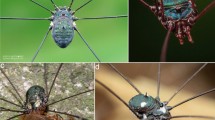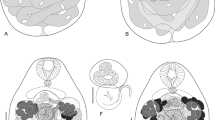Abstract
An annotated list and an original illustrated key to five species of the genus Trilia are given. Lectotype of Trilia deserticola Popov, 1957 is designated. Trilia sola sp. n. is described from Western Kazakhstan. The new species differs from all the congeners in the following characters: head transversely oval in front view; maxillary palpi short; marginal cell of fore wing short, as long (along costal margin) as pterostigma. The holotype is deposited in the Zoological Institute, the Russian Academy of Sciences (St. Petersburg).
Similar content being viewed by others
References
Ebmer, A.W., “Die westpaläarktischen Arten der Gattung Dufourea Lepeletier 1841 mit lllustrierten Bestimmungstabellen (Insecta: Hymenoptera: Apoidea: Halictidae: Dufoureinae),” Senckenbergiana Biol. 64(4/6), 313–379 (1984).
Ebmer, A.W., “Die westpaläarktischen Arten der Gattung Dufourea Lepeletier 1841 mit lllustrierten Bestimmungstabellen (Insecta: Hymenoptera: Apoidea: Halictidae: Dufoureinae). Nachtrag,” Linzer Biol. Beitr. 19(1), 43–56 (1987).
Ebmer, A.W., “Die westpaläarktischen Arten der Gattung Dufourea Lepeletier 1841 (Insecta: Hymenoptera: Apoidea: Halictidae: Rophitinae). Funfter Nachtrag,” Linzer Biol. Beitr. 40(1), 581–625 (2008).
Michener, Ch.D., The Bees of the World (J. Hopkins Univ., Baltimore, London, 2000).
Michener, Ch.D., The Bees of the World, 2nd edition (J. Hopkins Univ., Baltimore, London, 2007).
Pesenko, Yu.A., “Halictidae, Subfamily Halictinae, Tribe Nomioidini (in the Palaearctic Fauna) (Nauka, Leningrad, 1983) (The Fauna of the USSR, Hymenoptera, Vol. 18, Issue 1. New Series, No. 129) [in Russian].
Pesenko, Yu.A., “Family Halictidae. Introduction,” in A Key to the Insects of the Russian Far East. Vol. 4. Neuropteroidea, Mecoptera, Hymenoptera. Part 5 (Dal’nauka, Vladivostok, 2007), pp. 745–754 [in Russian].
Pesenko, Yu. A. and Astafurova, Yu.V., “Contributions to the Halictid Fauna of the Eastern Palaearctic Region: Subfamily Rophitinae (Hymenoptera: Halictidae),” Entomofauna 27(27), 317–356 (2006).
Pesenko, Yu.A. and Astafurova, Yu.V., “Family Halictidae, A Key to the Eastern Palaearctic Species of the Family Halictidae: 1. Subfam. Rophitinae,” in A Key to the Insects of the Russian Far East. Vol. 4. Neuropteroidea, Mecoptera, Hymenoptera. Part 5 (Dal’nauka, Vladivostok, 2007), pp. 804–815 [in Russian].
Popov, V.V., “About the Genera Morawitzella gen. nov. and Trilia Vach. (Hymenoptera, Halictidae),” Entomol. Obozr. 36(4), 916–924 (1957)
Vachal, J., “Contributions hyménoptèriques: I. Nouveau sous genre et nouvelle espèce du genre Dufourea Lep.,” Ann. Soc. Entomol. France. 68, 534–539 [(1899) 1900].
Warncke, K., Beiträge zur Bienenfauna des Iran: 3. Die Gattung Rophites Spin., mit einer Revision der Westpaläarktischen Arten der Bienengattung Rophites Spin.,” Boll. Mus. Civ. Stor. Nat. Venezia 30, 111–155 (1979).
Author information
Authors and Affiliations
Additional information
Original Russian Text © Yu.V. Astafurova, 2010, published in Entomologicheskoe Obozrenie, 2010, Vol. 89, No. 2, pp. 454–458.
Rights and permissions
About this article
Cite this article
Astafurova, Y.V. A review of the genus Trilia Vachal (Hymenoptera Halictidae Rophitinae). Entmol. Rev. 90, 760–763 (2010). https://doi.org/10.1134/S0013873810060126
Received:
Published:
Issue Date:
DOI: https://doi.org/10.1134/S0013873810060126




